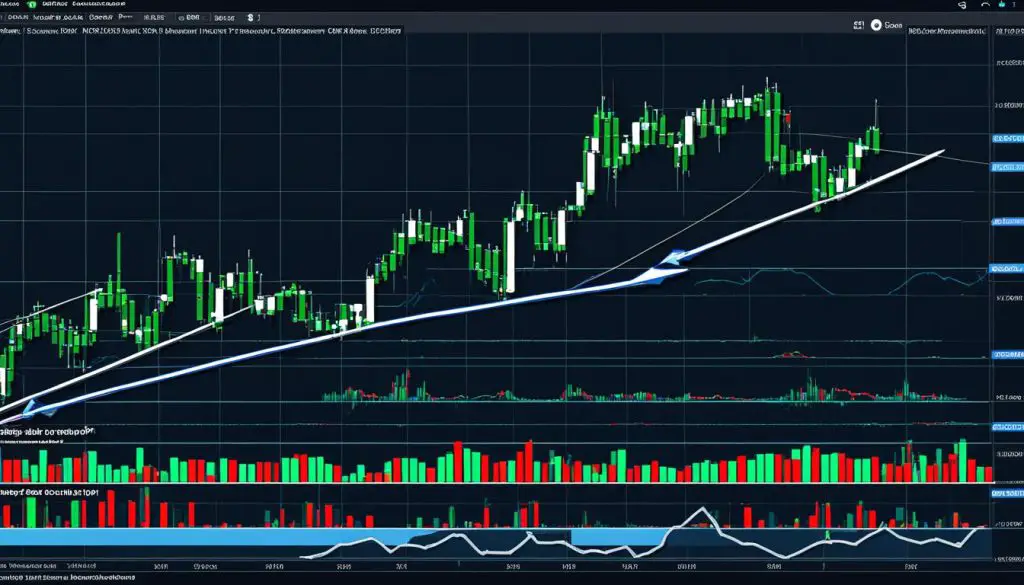The intricacies of the forex market structure are as compelling as they are complex, particularly when it comes to the minor structure in forex. For investors and traders looking to diversify their portfolio beyond the regular major currency pairs, delving into the world of minor pairs offers a fresh perspective marbled with unique challenges and opportunities. Unlike their major counterparts, minor currency pairs do not include the US dollar, instead pairing together other significant currencies such as the Euro, the British Pound, or the Australian dollar among others.
In this exploration of the forex technical analysis and forex trading strategies associated with these less common pairs, we’ll uncover why these minor gems garner attention for their potential to yield substantial returns. Despite lower liquidity and trading volumes, the minor pairs can swing with wider arcs, offering vigilant traders the chance at lucrative rewards. Yet, the key to navigating these turbulent waters lies in a profound understanding of their nuanced behaviors within the larger currency matrix.
The Essence of Minor Structure in Forex
Understanding the forex minor structure is key to expanding trading horizons beyond the major currency pairs. As one delves into the world of minor forex pairs, it becomes evident that these instruments are subject to different market forces. The lack of a direct tie to the US dollar gives these pairs characteristics such as lower liquidity and distinct forex price action patterns – elements that a well-informed trader can leverage to their advantage.
Defining Minor Currency Pairs
Minor currency pairs, often referred to as ‘crosses,’ are pairs that do not include the US dollar. Despite being less traded, they present unique opportunities for those willing to explore the forex market’s full breadth. For instance, minor forex pairs like EUR/GBP and GBP/JPY, while they may not catch headlines, move in patterns that can be deciphered and predicted by astute market participants. Understanding these pairs entails recognizing the interplay between differing economies and exploiting the nuanced forex price action that unfolds as a result.
Importance of Understanding Forex Market Structure
Having a firm grip on the structure of the forex market enables traders to navigate through complex price movements with greater confidence. This structure is not just about identifying the most traded pairs; it’s also about comprehending how market trends are formed and the way in which currency values are influenced by global economic events. Whether a trader chooses to go with the trend or take a contrarian approach, an in-depth understanding of minor currency pairs lays the foundation for a robust strategy tailored to capitalize on less obvious market shifts.
Armed with knowledge about minor forex pairs and the overarching market structure, traders can enhance their trading strategies and decision-making processes. This wisdom, combined with a solid grasp of forex price action, can play a pivotal role in achieving success within the dynamic realm of forex trading.
Comparing Major and Minor Forex Pairs
When venturing into the world of forex, traders are often curiously divided between focusing on major pairs known for their stability, and minor pairs which are lauded for their potentially lucrative volatility. Both sets of pairs present unique opportunities and challenges, and a deep dive into their characteristics is essential for crafting tailored trading strategies. Engaging in the trading of minor currency pairs requires an intricate understanding of both forex technical analysis and the art of identifying critical support and resistance levels in the forex market.
Liquidity and Volatility Differences
The principal distinction between major and minor forex pairs can be observed in their liquidity. Majors, being intertwined with the US dollar, boast high liquidity translating to tighter spreads and smoother price movements. Consequently, this affects the approach a trader must take towards forex technical analysis.
In contrast, minor currency pairs are known for erratic price changes driven by economic events affecting smaller economies. Their lower liquidity leads to wider spreads and, therefore, a higher cost per trade. This volatility, however, can be appealing to the opportunistic trader, provided they have a solid grasp of market data and trends.
Trading Volumes and Market Stability
Trading volumes drastically affect market stability, a factor that shouldn’t be overlooked when trading minor currency pairs. With majors involving the US dollar, the sheer volume of trades underpins a certain degree of predictability in the face of global economic shifts. Yet, for minors, the path is less trodden, creating space for larger price jumps and noteworthy trading opportunities—coupled predictably with increased risk.
Gauging the intricate dance of supply and demand becomes fundamental. Traders who commit to understanding this dynamic are better equipped to use forex technical analysis to anticipate and navigate the tides of the forex market. Additionally, proficiency in pinpointing accurate support and resistance levels in forex can immensely aid in mitigating the inherent risks of engaging with minor pairs.
| Currency Pair Type | Liquidity | Volatility | Average Spreads | Typical Trading Volume |
|---|---|---|---|---|
| Major Pairs (e.g., EUR/USD) | High | Low to Moderate | Narrow | Very High |
| Minor Pairs (e.g., EUR/GBP) | Low to Medium | High | Wide | Low to Moderate |
Lastly, while some traders may be enticed by the frequent and sharp movements of minor pairs, developing a strategy that takes into account the more stable and less abrupt movements of majors might align better with certain risk profiles. It’s clear that a trader’s success in the forex market is largely determined by their ability to strategize based on the inherent characteristics of the currency pairs they choose to engage with.
Technical Analysis and Minor Forex Pairs
For serious forex traders, forex technical analysis is an indispensable tool. By examining historical forex price action, investors aim to predict future trends and fluctuations, particularly within the realm of minor forex pairs. Such pairs can demonstrate heightened volatility due to their thinner market depth, which brings both challenges and opportunities to the table.
Engaging in forex trading strategies for these pairs calls for a nuanced approach. One cannot rely solely on major market analysis techniques; instead, traders must also incorporate methods uniquely suited for these less liquid assets.
- Assessment of unique chart patterns prevalent in these currency combinations
- Incorporation of technical indicators that can handle erratic price movements
- Development of strategies for both longer-term trends and short-term price spikes
Below is a structured analysis of the key considerations when dealing with minor pairs in forex:
| Aspect | Major Pairs | Minor Pairs |
|---|---|---|
| Market Liquidity | Higher | Lower |
| Volatility | Lower | Higher |
| Price Sensitivity to News | Moderate | High |
| Technical Indicators Reliability | Consistent | Variable |
| Chart Patterns | Clear | Complex |
It’s evident that engaging with minor forex pairs requires an adaptive technical analysis approach, tailored to overcome the discrepancies in market behavior and liquidity levels. Successful traders in this sphere recognize the necessity of education and continual learning, alongside the flexibility to adjust their forex trading strategies in sync with market dynamics.
To master trading in these unpredictable conditions, dedicated practice and attention to detail become essential. Experienced traders know that minor pairs, while offering enticing profit possibilities, also demand a higher level of market vigilance, preparedness for swift tactical changes, and an in-depth understanding of diverse forex trading strategies.
Building Forex Trading Strategies with Minor Pairs
Deep-diving into the realm of minor pairs in forex necessitates a blend of analytical proficiency and adaptive trading methods. To exploit the innate volatility and potential rewards these pairs present, traders implement robust forex trading strategies, supported by rigorous forex technical analysis and a nuanced understanding of forex price action.
Incorporating Support and Resistance in Forex
Support and resistance levels are the linchpins of trading minor forex pairs. These levels signal areas where price movements can halt and possibly reverse, providing crucial information for identifying entry and exit points in the market. By delineating these thresholds, traders gain insights into market sentiment and potential price barriers.
- Support levels: Suggest potential buying opportunities where price declines could stall and bounce upwards.
- Resistance levels: Indicate selling possibilities where price rallies are prone to a pause or reversal.
Recognizing these zones allows traders to anticipate market behavior around these pivotal points, enhancing the efficacy of their forex trading strategies.
Utilizing Price Action in Minor Pairs
Price action in forex is the heartbeat of the market, revealed through candlestick patterns and price movements. For minor forex pairs, where volatility is a given, understanding price action is instrumental. It not only sheds light on the ongoing narrative of buyer and seller dynamics but also uncovers the subtlest hints of market change.
Studying the nuances of candlestick formations like dojis, hammers, and engulfing bars assists traders in discerning potential shifts in trend and momentum. This knowledge is essential for formulating responsive strategies that capitalize on rapid price changes typical of minor pairs.
| Candlestick Pattern | Indication | Possible Strategy |
|---|---|---|
| Doji | Market indecision | Prepare for potential upcoming trend reversal |
| Hammer/Hanging Man | Potential end of a downtrend/upward momentum | Consider long positions after confirmation |
| Engulfing Bar | Reversal of current trend | Enter trade in the direction of engulfing bar post-confirmation |
| Shooting Star | Probable end of uptrend/downturn reversal | Wait for bearish confirmation to initiate short positions |
In summary, the intersection of support and resistance principles with price action observations serves as the foundation for creating resilient and informed trading strategies. This becomes especially pertinent when facing the less-charted waters of minor forex pairs, where such technical comprehension can provide a trader with the competitive edge needed to thrive in forex market’s dynamic environment.
Minor Structure in Forex and Economic Indicators
The intricate interplay between minor currency pairs and economic indicators is a critical component of forex market structure. As minor currencies react to their respective economic narratives, traders must integrate this awareness into their forex technical analysis to optimize their positions. Observing the economic policies that shape the movements of these pairs can provide predictive insights into their potential direction in the forex markets.
Impact of Economic Policies on Minor Currencies
Minor currencies are uniquely susceptible to the shifts in economic policies within their home nations. Shifts in interest rates, fluctuations in GDP growth, and the outcomes of political events are notable economic indicators that can cause waves in the relatively shallow pools of minor pairs’ liquidity. A surge or dip in these indicators can be the harbinger of a substantial swing in value, underscoring the necessity for astute attention to such economic signposts by forex traders.
Trading Minor Currency Pairs During Economic Releases
When it comes to trading minor currency pairs, timing around economic releases becomes particularly salient. These periods often herald heightened volatility, offering both risk and reward. Keen traders keep a close eye on economic calendars and central bank announcements, using these as a guide to navigate the tumultuous waters of forex trading with minor pairs. This information, integrated with robust forex technical analysis, equips traders with the foresight needed to manage their trades strategically in the face of potential market upheaval.






